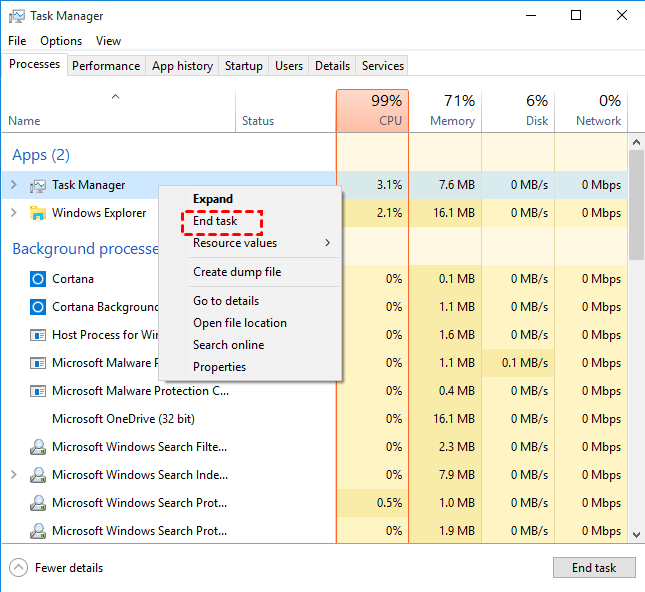[6 Ways] Fix Windows 7 Slow When Running/Startup/Shutdown
Windows 7 slowed down? Taking a long time to start up and shut down, don’t worry! This article will teach you how to fix a slow Windows computer effectively with 6 methods.
Scenario: Windows 7 is very slow
Window 7 incredibly slow (hope you guys really read this and not just copy paste the tips from nowhere)
There’s a problem with my Windows 7. It takes about 8 minutes to completely boot up and log in. Every time after I log in, the desktop is completely black, and it takes another 3 minutes to load the Windows UI and desktop.
I can’t even use the web browser like a normal person—it’s extremely laggy no matter what I’m doing: starting up, running the PC, or even shutting it down. I’ve tried the Microsoft Performance Troubleshooter, Fix-It tools, sfc /scannow, and I’ve also run the Safety Scanner… but nothing works. I don’t know what to do now—my HDD is just the definition of slow.
- Question from answers.microsoft.com
Why is Windows 7 so slow?
Is Your Windows 7 running slow? Whether your PC gradually became slower or it suddenly shut down, you can refer to the reasons below for this slowness. To have a clear glance, here we prepare a table for you:
| Cause | Explanation | Solution |
|---|---|---|
| Too many programs running | Multiple programs use up CPU and memory, especially those running in the background. | Turn off unnecessary programs via Task Manager (Ctrl + Alt + Delete). |
| Fragmented files | Files scattered across the disk take longer to access, slowing down read/write speed. | Defrag your hard disk using Windows' built-in Disk Defragmenter tool. |
| C drive is full | Low storage on system partition (C:) restricts Windows' ability to operate efficiently. | Extend the system partition using AOMEI Partition Assistant. |
| SSD partition is misaligned | Improper alignment reduces SSD performance, affecting overall speed. | Perform professional 4K SSD partition alignment using AOMEI software. |
| Excessive dust inside the PC | Dust buildup reduces cooling efficiency, causing overheating and slow performance. | Clean the dust from fans and vents regularly. |
| Virus infection | Malware can consume system resources or interfere with normal operations. | Run a PC scanner and cleaner to remove viruses before applying any other solutions. |
| General performance issues | Windows settings or configurations might be affecting speed. | Run Performance Troubleshooter via Control Panel > Troubleshooting > Check performance. |
6 Methods to speed up a slow Windows 7 computer
To effectively fix a slow Windows 7 system—whether it's during startup, while running, or when shutting down—you can try the 6 methods provided in this section. If you already know the cause of the slowdown, you can go directly to the corresponding solution using the table of contents on the left.
Before you begin, please download AOMEI Partition Assistant, as we’ll be using many of its features to address the Windows 7 performance issues. This all-in-one utility supports expanding the C drive, speeding up your computer, checking SSD partitions for alignment, fixing hard disk errors, and more.
The Best Windows Disk Partition Manager and PC Optimizer
But first, you should use an anti-virus to check if your computer got affected by a virus.
Method 1. Run Performance Troubleshooter
The first thing that you can try is the Performance troubleshooter, which can automatically find and fix problems. It will check issues that might slow down your computer's performance.
Step 1. Click the Start button on the desktop, and click "Control Panel".
Step 2. Type “Troubleshooter” in the search box. Open the Troubleshooting program on the search result.
Step 3. In the Troubleshooting window, click “Check for performance issues”.
Step 4. Then it will pop up the performance checking program, and follow the instructions and fix the detected problem. Then see if the “Windows 7 slow” problem is fixed.
Method 2. Turn off unnecessary programs
Windows 7 slow is usually caused by too many programs running at the same time, which takes up processing power and reduces the performance of the PC. Even if some programs are closed, they will continue to run in the background or start automatically when you start the computer.
To see which background programs are running on your PC and how much capacity and processing power they occupy, please open the "Task Manager", which you can access by pressing CTRL + ALT + DELETE.
🔥Method 3. Extend system partition
If your system partition is getting full, Windows 7 will run very slowly, in this situation, you should extend your system partition. AOMEI Partition Assistant can help you solve the problem. It is a professional disk management tool, the functions of extending system drive and Partition Alignment can help you improve the performance of your PC easily and quickly. It also supports creating, shrinking, moving, and formatting disk partitions to manage your disk more flexibly. Now, I will show you how to extend system partition with AOMEI Partition Assistant step by step.
The Best Windows Disk Partition Manager and PC Optimizer
Step 1. Install and launch AOMEI Partition Assistant. Then, all disks and partitions will appear on the main interface.
Step 2. In this demonstrator, there is unallocated space behind the C drive. Then, right-click the partition (here is C drive) you want to extend and select "Resize/Move Partition". If the drive has enabled Bitlocker encryption, it also allows you to resize the encrypted partition.
Step 3. In the pop-up window, position the mouse pointer on the right border of the partition and drag the border rightwards to extend the partition. Then click "OK". (If there's no unallocated space beside the partition, you could not drag the border).
Step 4. Then it will back to the main interface and you could preview the C drive that has been being extended. Click the "Apply" on the toolbar to commit the operation.
PS.: If there is no unallocated space on the system hard drive or adjacent unallocated space behind the system partition, please refer to how to allocate free space.
Method 4. Defrag your hard disk
When we usually use computers, repeated deletions and downloads will form disk fragments. Because the file storage sectors are not continuous, the reading time will become longer, so Windows 7 will run slow. But fortunately, we can solve this problem with defragmentation.
The purpose of defragmentation is to reorganize scattered files together continuously to improve the seek speed of the computer.
You can try the defragmentation tool that comes with Windows 7:
Step 1. Open "This PC" on the desktop, and right-click on a drive, like C drive, and choose "Properties".
Step 2. Choose the "Tools" tab, and click "Optimize"
Step 3. Analyze all the drive one by one, and click "Defragment Disk".
If you don't like defragging hard drives manually, you can set a schedule defrag so that your hard drives can get optimized daily, weekly, or monthly.
Method 5. Clean up the dust
The CPU fan helps dissipate heat, but it easily attracts dust due to static electricity. Over time, if not cleaned regularly, dust can build up around the air vents and components, leading to poor heat dissipation and causing Windows 7 to run slowly.
You can open the computer case using a screwdriver to check inside—you’ll likely find dust accumulated around the graphics card, cooling fan, and at the bottom of the case. Regularly cleaning out the dust will significantly improve cooling efficiency and overall system performance.
🔥Method 6. Align SSD partition
It is believed that SSD is better than HDD, if you still want to pursue a faster read and write performance, you can Migrate OS from HDD to SSD. But if you are already using SSD, You must not ignore 4K alignment.
Partition misalignment is another very common reason why Windows 7 runs slow. It causes slowdowns in performance. And AOMEI Partition Assistant could allow you to check whether SSD partitions are aligned, and enable you to realize partition 4K alignment easily.
The Best Windows Disk Partition Manager and PC Optimizer
Step 1. Install and launch the software, right-click the SSD partition, and choose "Advanced" > "Partition Alignment".
Step 2. You can set partition 4K alignment in this mini window. Usually, we recommend the "2048 Sector". Click "OK" to continue.
Step 3. Finally, click "Apply" to save changes.
Conclusion
After reading this article, I believe you have more understanding about how to solve Windows 7 slow issue. Before performing these operations, you should use anti-virus software to scan the computer to ensure that there are no viruses that affect computer performance. By the way, If your computer is running with Windows Server system, you can turn to AOMEI Partition Assistant Server Edition.


